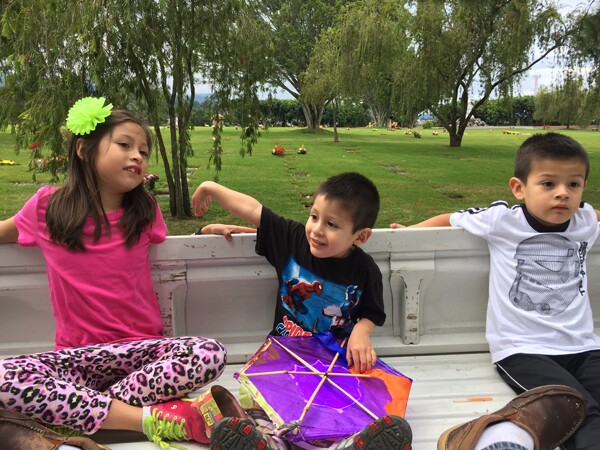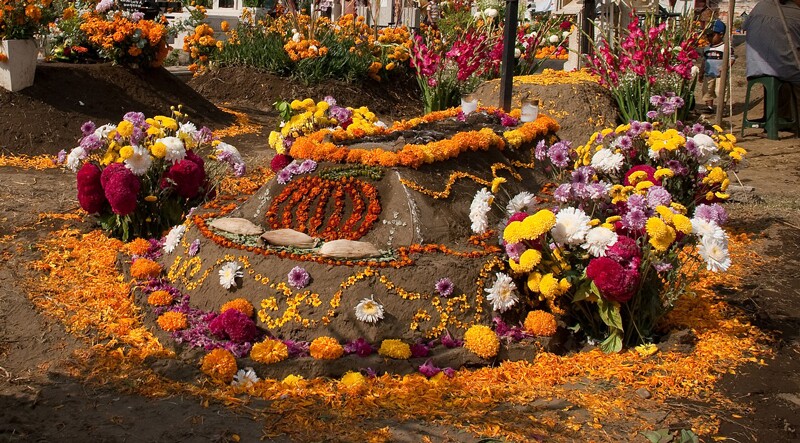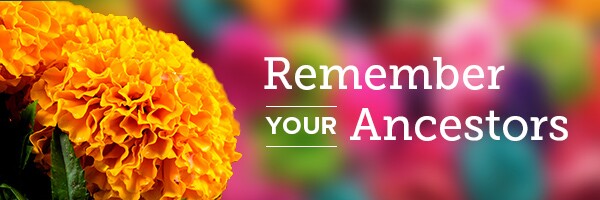How do you remember tus antepasados—your ancestors? Do you have those memories preserved so they can be passed on to future generations?
Recently, I told my children the story of a man who recorded all his knowledge on the walls of a cave with the hope that one day this knowledge would be passed on, and others would remember him. The drive to be remembered and to remember your ancestors is powerful. That is why so many cultures have holidays and festivals to celebrate the memories of deceased loved ones.
If this man in my story were living in the 21st century, his journal may have been a notebook, video, blog, or album full of pictures. His children may have added their memories of him as they gathered around their ofrenda or wrote calaveras literarias. We take these memories of our ancestors and celebrate them, share them with our familia, our family. Do you have memories from tus abuelos—your grandparents? What about tus padres—your parents? How can you pass on your own story?
Día de Muertos—Celebrating Day of the Dead and All Saints Day
If you celebrate a holiday such as Día de Muertos or Día de Difuntos, you already have traditions for keeping the memories of your ancestors alive and retelling their stories. Or maybe you haven’t participated in these rich traditions but find them interesting after learning about them from secondary sources such as the Disney movie Coco. Exploring both old and new traditions is a great way to begin remembering your ancestors as unique individuals.
In Guatemala, where I live, the end-of-the-year holidays are very popular. There’s “All Saints Day” or “Day of the Dead” in November (Día de todos los Santos or Día de Muertos). There’s Día de los Niños, “Day of the Children,” in October. We even include remembering our ancestors as part of our Christmas celebrations in December. The way people celebrate these holidays depends on where they live.
Mi padre was born in the west part of Guatemala, and I was born in Guatemala City. The traditions we have for Día de Muertos are different, but both are very rich and significant, focusing on family relationships and remembering ancestors.
Cometa—Sending Messages to Ancestors
My father was raised with the tradition of making cometa, or kites, for Día de Muertos. He would search for straws in the dried stalks to help mi bisabuela (my great-grandmother) make kites and sell them to friends and neighbors. A few weeks before the Day of the Dead celebration, the rain would slow and the wind would start to blow to make the kites fly. Mi padre learned the kites symbolized sending messages to loved ones who have left this life. Later, my great-grandmother would let my dad make his own kites, which he loved to fly.

Cempasúchil, Calavera, and Fiambre—Decorating the Tombs of Ancestors
Day of the Dead celebrations, regardless of the country, are filled with cempasúchil, flowers, and calavera, skulls. Both are symbolic of the temporary nature of mortality and the immortality of the soul or human spirit. Many people use marigolds during Día de Muertos, preferring them for their rich colors and aroma. Mi abuelo made stone flowers for people to use, and I remember selling both with my family for the holiday.
Families spend a lot of time preparing the graves of deceased ancestors with marigolds, calavera, photos, memorabilia, and the ancestor’s preferred foods and drinks. All these practices are believed to attract the spirit of the deceased ancestor, who is believed to visit living family members during the festivities.

Image by Eneas de Troya
Three or four days before Día de Muertos,mi abuelo would buy paint and make a mixture with a water base. He would send my dad with his brothers to the San Marcos cemetery to clean and paint our ancestors’ tombs. We honor our ancestors’ resting places and appreciate the heritage of family recipes. Today mi familia prepares a fiambre, a special plate for the Day of the Dead. The fiambre is a mix of cultural recipes with Creole and native flavors from the region, and it’s a way to bring families together.
Recordando a los Muertos Comienza con los Vivos—Remembering the Dead Starts with the Living
More than 33 years ago, mis padres started to write a family journal in a blue notebook. It was in this journal that the history of my life first began to be recorded, including details from before my birth.
Today we have Instagram Stories, Facebook Biographies, Memories on FamilySearch, and thousands of other applications that offer easy and simple solutions for keeping a diary of our lives. Why do we share so much on social media?The other day I found the answer in something a youth said: “We share stories because we want to be remembered.” Simple.

At the birthday of my third child, we decided we would start a new tradition in my family. I asked family members to look for a connection with our ancestors by sharing a memory they have—one that others might not know. During the activity, I could see my family members were each having a significant experience, especially with the connections they were making between themselves as they spoke about their ancestors. It was like an invisible power was bonding them together as they told stories to each other.How can you remember your ancestors? Do you have a place to store all these memories of your family, both the living and the deceased?
Using FamilySearch to Remember Your Ancestors
FamilySearch has an app you can use to help you record, preserve, and share these family stories. With the Memories app, you can gather and preserve the stories of tu familia and each of your ancestors. Download the app, and consider these five tips for how you can preserve memories during Día de Muertos—or any time you want to honor your ancestors.
- Preserve memories as they are celebrated. When your family places your ancestor’s photo on yourofrenda, have you thought to preserve that photo somewhere you can see it any time? You can upload the photos of your ancestors—and much more—to the Memories app as you honor your ancestor year after year. Favorite recipes from tu bisabuela, pictures of her decorated gravestone, poems you write for her, and all sorts of memories can be stored and shared with the Memories app. You can tag these memories with your ancestor’s name so all your relatives can experience your great-grandmother’s traditions as well.

- Record stories as they are shared. Do you have a tradition of sharing family stories? Would you like to start one? Every time a story is passed on, there’s an opportunity to record it and place it somewhere you and your family can revisit any time. You can record a story or memory as text or audio right when you hear it and then upload it to the FamilySearch Memories app.
- Upload memories as they are created. Your deceased relatives are not the only ones worth remembering. All of us cherish precious moments with our children, siblings, parents, or whomever we consider our family. The photos you save on your phone, the stories that come from family gatherings, events, and random life moments—preserve those memories now so your family will have them to look back on. The great thing about the Memories app is that you can use it to collect all your family stories in one place, and you can do it from your phone or other mobile device.
- Make preserving memories part of your tradition. You and each of your family members have so many stories to share. Día de Muertos, Día de Todos los Santos, and every tradition for remembering your ancestors are perfect opportunities to help build a collection of your family stories. When you start or participate in family traditions, use the Memories app or your family’s choice medium to grow this precious family history.
- Start now! Using the Memories app is very simple, and it is freely accessible. With the Family Tree app and the FamilySearch.org desktop site, you can upload and access your family’s memories on your FamilySearch tree. This resource is a great way to preserve and look at the stories of tu familia from each generation.
Family history is something that is worth sharing. Through it we are remembered, and we remember our ancestors. They deserve to be remembered, as do you.


